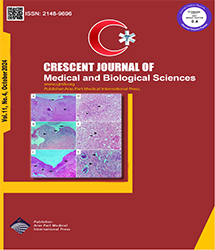
| Original Article | |
| Evaluating the Effect of Silibinin on the Expression of Pannexin1 Gene During Hepatic Ischemia-Reperfusion | |
| Hadis Musavi1, Mohamad Sadegh Safaee2, Zohreh Nasiri3, Fatemeh Ghorbani4, Parisa Mohamadi1, Elham Rostami5, Abbas Khonakdar-Tarsi6, Mobina Faghani Lor6 | |
| 1Department of Clinical Biochemistry, School of Medicine, Babol University of Medical Sciences, Babol, Iran 2Department of Biology, Faculty of Biology Sciences, Islamic Azad University, North Tehran Branch, Iran 3Department of Clinical Biochemistry, Shahid Beheshti University of Medical Sciences, Tehran, Iran 4Department of Clinical Biochemistry, Tehran University of Medical Sciences, Tehran, Iran 5Department of Biology, School of Science, Shahid Chamran University of Ahvaz, Ahvaz, Iran 6Department of Clinical Biochemistry and Genetics, Faculty of Medicine, Mazandaran University of Medical Sciences, Sari, Iran |
|
|
CJMB 2024; 11: 190-194 DOI: 10.34172/cjmb.2023.34 Viewed : 3515 times Downloaded : 3425 times. Keywords : Ischemia, Pannexin-1, Reperfusion, Silibinin |
|
| Full Text(PDF) | Related Articles | |
| Abstract | |
Objectives: Liver ischemia-reperfusion (I/R) is the director"s origin of damages in various clinical situations, especially surgery and transplantation. Inflammatory damages are critical because of the chronicity of I/R injuries (I/RI). The hepatoprotective and anti-inflammatory properties of silibinin have been reported in different studies. This study aimed to investigate the effect of Silibinin on the expression of the pannexin-1 (Panx1) gene during hepatic I/R. Materials and Methods: In this case-control animal study, a total of 32 male Wistar rats (n=8 in each) were surveyed. The animals were randomly assigned into four equal groups as follows: Group 1 (Control): the rats underwent a midline laparotomy with normal saline injection; Group 2 (SILI): the rats received Silibinin (50 mg/kg) after laparotomy; Group 3 (I/R): the rats underwent I/R surgery and received normal saline; and Group 4 (I/R+SILI): the rats received silibinin before ischemia and directly following reperfusion. Blood and liver tissue samples were taken after three hours of reperfusion aftermath 1-hour ischemia to evaluate histological changes, gene expression, and serum markers of hepatic injury. Results: While the serum aspartate aminotransferase (AST) and alanine aminotransferase (ALT) levels in the I/R group significantly increased compared to the control group (P < 0.001), they significantly decreased in the SILI+I/R group (P < 0.001). Silibinin ameliorated inflammatory impairments of liver tissue, such as neutrophil and macrophage infiltration and activation, hepatocyte degeneration and vacuolation, hepatic vascular endothelial damage, and sinusoid proliferation in the I/R group. The expression of the Panx1 mRNA during I/R significantly increased compared to the control group (P < 0.001), but silibinin reduced the expression (P < 0.001). Conclusions: We witnessed that silibinin reduced liver tissue damages during hepatic I/R. Correcting the expression of the Panx1 gene during I/R is probably one of the mechanisms of anti-inflammatory effects of silibinin. |
Cite By, Google Scholar
Google Scholar
PubMed
Online Submission System
 CJMB ENDNOTE ® Style
CJMB ENDNOTE ® Style
 Tutorials
Tutorials
 Publication Charge
Medical and Biological Research Center
About Journal
Publication Charge
Medical and Biological Research Center
About Journal
Aras Part Medical International Press Editor-in-Chief
Arash Khaki
Deputy Editor
Zafer Akan



















